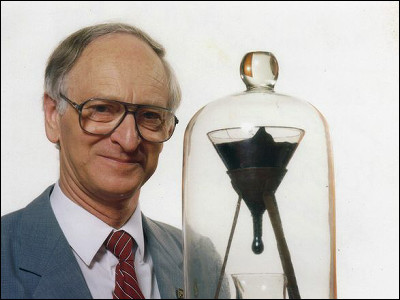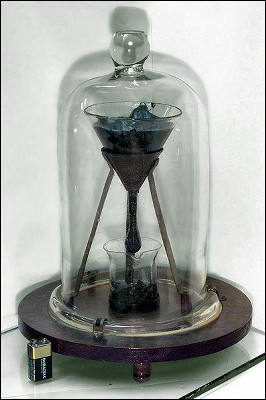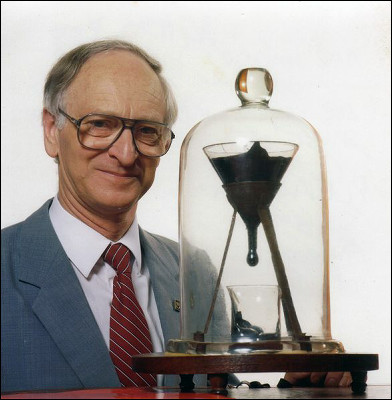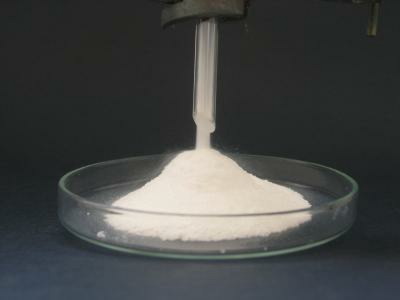What is the world's longest experiment 'pitch drop' that has been ongoing for 82 years?

The experiment has already been conducted for 82 years, and there is the longest experiment in the world certified by Guinness, which is said to continue for another 100 years. The 'Pitch Drop Experiment' was started at the
Pitch drop experiment --Wikipedia
https://en.wikipedia.org/wiki/Pitch_drop_experiment
School of Mathematics and Physics-University of Queensland
https://smp.uq.edu.au/
'Pitch drop experiment' is a drop experiment of a very viscous fluid called 'pitch'. It's extremely sticky (it's better to say it's sticky rather than sticky). The liquid that doesn't seem to move even if it's shaken, tilted, or turned upside down flows little by little over a long period of time, like a funnel. If you put it in the funnel, the time will come when the drops will drip, and it is the longest experiment in the world that has been observing the flow and the phenomenon of the drops for 82 years.
Then, what is 'pitch'? Liquids that are so viscous that they behave closer to solids, including those derived from natural vegetable resins and fossil fuels, are collectively called. Something like black tar is also a pitch, and it is also the origin of the expression 'pitch black' that darkness that you can not see anything in English.
The pitch used in the experiment introduced this time is a substance called ' Bitumen ' derived from fossil fuels. It is mainly composed of polycyclic aromatic hydrocarbons and has the property of dissolving in carbon disulfide . It has been used for paving roads and waterproofing ships.
If you can't imagine what it's like, on the experiment introduction page of the University of Queensland, 'Pitch is such a substance. If you hit it with a hammer, it will break like this,' Zaratustra said in a magnificent manner. You can see a video clip (Windows Media Player) that explains.
This is the experimental device.

In 1927, Professor Thomas Parnell of the University of Queensland showed his students that 'some substances that look like solids and have solid-like properties are actually very viscous fluids.' This experiment started in. Pitch was poured into a funnel with a seal on the foot (the tubular part that extends down), and after letting it sit for three years to stabilize, the funnel was unsealed in 1930 and the pitch began to flow. After that, about one large drop drops every 10 years. The first drop fell in 1938. The pace at which the drops fell after that was as follows.
First drop: December 1938
Second drop: February 1947
Third drop: April 1954
Fourth drop: May 1962
5th drop: August 1970
6th drop: April 1979
7th drop: July 1988
8th drop: November 28, 2000
Initially, the temperature of the experimental environment was not controlled, so the viscosity changed depending on the temperature throughout the year (the viscosity of the liquid decreases as the temperature rises), but air conditioning after the 7th drop dropped in 1988. Is introduced, and it is said that the time until the part where the pitch hangs away from the main body in the funnel and falls due to the stability of the temperature is longer than before. It seems that this is the reason why the 7th to 8th drops took 12 years even though they were dropped at intervals of about 8 to 9 years.
A student who was an 18-year-old freshman 82 years ago is now 100 years old. Professor Thomas Parnell died in 1948, but the experiment has continued for generations. But sadly, no one has witnessed the moment when the pitch actually dropped.
Professor John Mainstone (currently an emeritus professor) who has taken over the experiment since 1990.

Professor Mainstone, who has left the saying, 'It is not an eye to observe the grass grow and the paint dries,' said that he did not see the moment when the pitch dropped while managing the experiment for 18 years. I can't help but hope that the 9th drop will fall in front of Professor Mainstone.
By the way, Professor John Mainstone and the late Professor Thomas Parnell received the Ig Nobel Prize in Physics (a parody of the Nobel Prize for 'Ignoble') in 2005.
As a result of this experiment, it has been calculated that this pitch is about 100 billion (10 to the 11th power) times the viscosity of water. It may be hard to imagine that the viscosity is 100 billion times, but it is tremendous to think that the viscosity of mayonnaise is about 10,000 times that of water and the pitch is 10 million times that.
So, the world is waiting for the moment when the next drop falls, and the pattern of this experiment is being broadcast on the webcam, so those who are extremely lucky may be able to witness the historic moment in real time. Maybe. Even when the drop dropped in 2000, it was being broadcast on the webcam, but it was not possible to record due to technical trouble. The webcam of the experiment broadcast is from the following.
mms: //drop.physics.uq.edu.au/PitchDropLive (Windows Media Player)
* It looks like a still image, but it is a video .
This 'pitch drop experiment', which is also listed in the Guinness Book of Records as 'the longest ongoing experiment in the world', is predicted to be able to continue for another 100 years from the remaining amount of pitch in the funnel.
・ Continued
The person in charge of the world's longest experiment 'Pitch Drop' died without witnessing the decisive moment, a summary of the flow so far --GIGAZINE

Related Posts:
in Note, Posted by darkhorse_log






